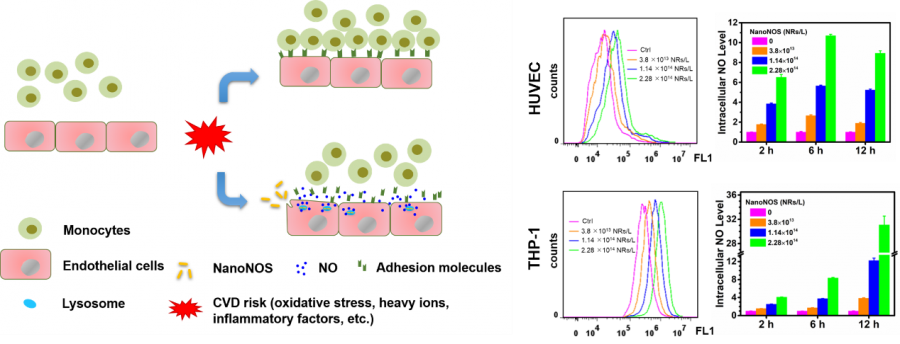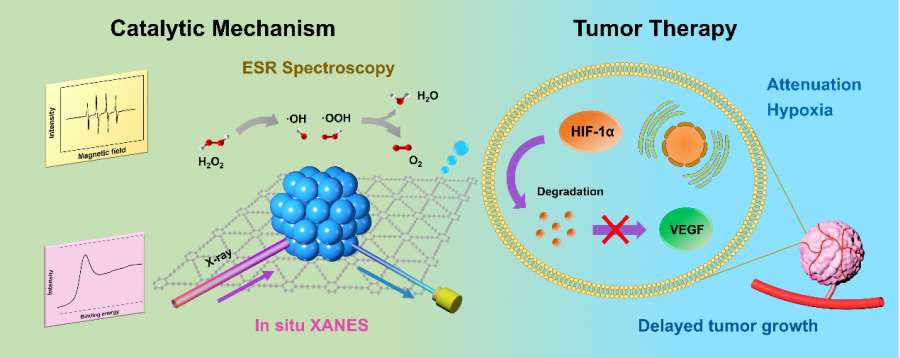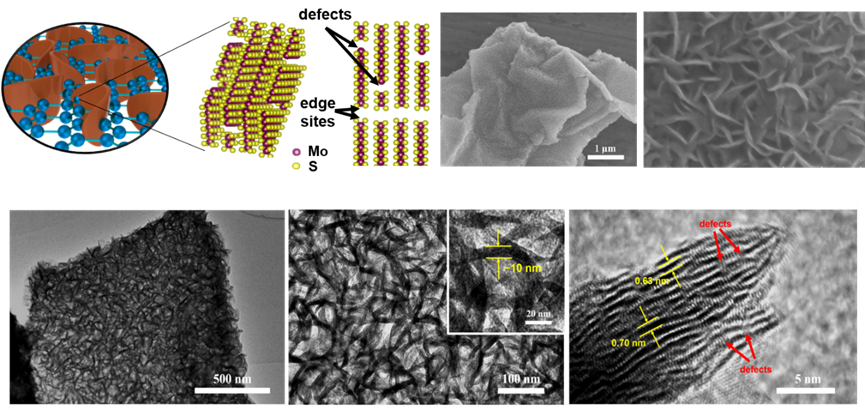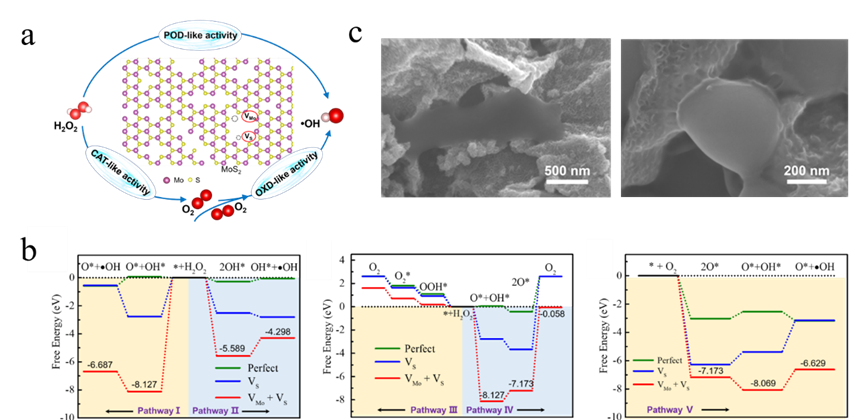
hotline:
17715390137
Tel/Wechat:
18101240246 (Technology)
0512-68565571
Email:mxenes@163.com (Sales Engineer)bkxc.bonnie@gmail.com
Scan the code to follow or search the official account on WeChat:
2D Materials Fronrier After paying attention,
click on the lower right corner to contact us,
Enter enterprise WeChat.
Professional Services Online

Nanoenzymes are a class of biomimetic enzymes with high catalytic efficiency and stability, and have broad application prospects in the field of medical nanomaterials. The Chen Chunying research group of the National Nanoscience Center has developed a series of nanoenzymes with unique biocatalytic activity in recent years, and has further verified its enzyme-like activities at the cell and animal levels. The relevant results will be marked as "Gold Nanorod-Based Nanoplatform Catalyzes Constant" in 2020. NO Generation and Protects from Cardiovascular Injury", "Graphdiyne-Templated Palladium-Nanoparticle Assembly as a Robust Oxygen Generator to Attenuate Tumor Hypoxia" and "Defect-Rich Adhesive Molybdenum Disulfide/rGO Vertical Heterostructures with Enhanced Nanozyme Activity for Smart Bacterial Killing Application" are The topic was published in the journals ACS Nano, Nano Today and Advanced Materials.
01
Nanoenzymes with NADPH oxidase, SOD enzyme and NOS enzyme activities at the same time are used for the treatment of cardiovascular diseases
Cardiovascular disease is one of the most fatal diseases in the world. NO can protect the endothelium and can be used to treat and prevent cardiovascular diseases. Researchers Chunying Chen, Xiaochun Wu and Liming Wang jointly discovered that gold, platinum and palladium noble metal nanorods all exhibit nitric oxide synthase (NOS)-like activity, and the activity of this NanoNOS can be regulated by near-infrared light. Through theoretical calculations and experimental data analysis, it can be seen that the enzyme-like catalytic mechanism of NanoNOS may be: (1) generate superoxide anion NADPH + 2O2 → NADP+ + 2O2- + H+; (2) show superoxide dismutase (SOD)-like activity 2O2-+ 2H+ → O2 + H2O2; (3) H2O2 and L-Arg produce NO and citrulline L-Arginine + H2O2 → L-Citrulline + NO + 4H+ (Figure 1). NanoNOS inhibits the expression of endothelial cell adhesion factors by releasing NO and protects endothelial cells from the damage induced by stimuli and the adhesion of monocyte-endothelial cells (Figure 2). The report of this achievement not only broadens the biomedical application direction of nanoenzymes, but also provides new ideas for the prevention and treatment of cardiovascular diseases.

Figure 1. The catalytic mechanism of NanoNOS

Figure 2. Schematic diagram of NanoNOS protecting endothelial damage. Intracellular NO level is positively correlated with NanoNOS concentration and exposure time
02
Graphyne two-dimensional nanocomposite material simulates catalase for hypoxic tumor treatment
Nano-catalytic treatment of hypoxic tumors has attracted wide attention due to its high efficiency, in situ, and low toxicity. However, most nanomaterials are prone to degradation in organisms and lose their catalytic activity, leading to reduced catalytic stability and affecting the therapeutic effect. Therefore, in the long-term treatment of diseases, how to realize the durable and efficient catalysis of nano-catalysts is an urgent problem to be solved. In the field of bioengineering, in order to maintain the long-lasting and stable catalytic activity of biological enzymes, the biological enzymes are often fixed on the surface of the carrier through physical or chemical means to realize the immobilization of the enzymes, so that the enzymes have a catalytic effect in a certain space. Inspired by the immobilization of biological enzymes, Chen Chunying research team designed and prepared catalytic nanomaterials suitable for in vivo applications based on graphyne two-dimensional materials: it can fix catalytic nano-particles on the surface of a specific carrier through physical or chemical methods. It has strong catalytic performance in the local space; it can also avoid the agglomerationGraphyne (GDY) is a new type of two-dimensional carbon nanomaterials formed by sp and sp2 hybrid carbon atoms. It has abundant carbon chemical bonds, large conjugated systems and porous structural units. GDYs spaced sp/sp2 hybrid C atoms and regular pore structure units provide stable binding sites for catalytic metal nanoparticles. Based on the structural characteristics of graphyne, designed and prepared metal palladium-graphyne nanocomposites (PdNPs/GDY) with high stability and catalase-like catalytic activity, using ultra-small metal palladium nanoparticles (PdNPs) as catalysts It is stably anchored on the surface of GDY and makes it monodisperse on the surface without aggregation or degradation, showing stable and lasting catalytic activity. The Pd content in PdNPs/GDY can reach 19.6 wt%, which is much higher than other Pd-carbon nanocomposites. Different from the isotropic surface of graphene with uniform energy distribution, the sp and sp2 hybrid C atoms in GDY are distributed at intervals, and the two have different adsorption capacities for Pd atoms. Therefore, the choice of Pd atoms on the GDY surface Sexual adsorption makes it difficult to move and migrate, making PdNPs/GDY more stable (Figure 3).

Figure 3. Synthesis and chemical structure of PdNPs/GDY
During the catalysis process, GDY can maintain the low valence state of Pd atoms through electron transfer, thereby exhibiting sustained high catalytic activity. In vitro cell experiments and patient-derived tumor transplantation mouse model (PDX) experiments have proved that PdNPs/GDY can efficiently and continuously decompose tumor endogenous H2O2 to produce oxygen, significantly improve tumor hypoxia, and down-regulate hypoxia inducible factor (HIF-1α) )-Mediated tumor angiogenesis, thereby slowing down tumor growth. This kind of PdNPs/GDY nanocomposite catalytic therapy and chemotherapeutic drug DOX can achieve chemical-catalysis combined therapy, which can effectively inhibit tumor growth and achieve the purpose of tumor treatment (Figure 4). This research provides new ideas for the design and optimization of new nanomaterials for the catalytic treatment of hypoxic tumors.

Figure 4. Research on the enzymatic mechanism of PdNPs/GDY and tumor hypoxia treatment
03
"Three-in-one" MoS2/rGO vertical heterostructure with enzyme-like catalytic activity for the treatment of drug-resistant bacterial infections
Bacterial infections plague millions of people every year and have become a severe global public health problem. Due to the abuse of antibiotics, "super bacteria" with multi-drug resistance have emerged. Therefore, there is an urgent need to develop new reagents and new methods to treat bacterial infections. Nanozyme antibacterial therapy (NABT) is widely used as a new method with broad-spectrum antibacterial ability and no drug resistance. NABT usually uses artificial nanomaterials with intrinsic enzyme-like catalytic activity to catalyze H2O2 or O2 to produce reactive oxygen free radicals (ROS). ROS has a strong bactericidal ability and does not cause bacteria to develop drug resistance. In order to further enhance the bacterial trapping ability and catalytic activity of nanoenzymes in NABT, researcher Chen Chunying, Professor Liu Jing and researcher Yu Xin jointly designed a defect-rich MoS2/rGO vertical heterostructure (VHS). Its structure is that a few layers of MoS2 nanosheets grow vertically on the surface of rGO, exposing more edge active sites; and due to the rapid microwave synthesis method, Mo vacancies and S vacancies are formed (Figure 5). Both experimental and theoretical results show that MoS2/rGO VHS has three photo-enhanced enzymatic catalytic activities (oxidase-like, peroxidase-like and catalase-like) synergistically antibacterial. At the same time, due to the topological effect of the rough surface of the vertical heterostructure, it has an excellent ability to capture bacteria (Figure 6).

Figure 5. Few-layered MoS2 nanosheets are grown vertically on the surface of rGO, exposing more edge active sites and forming a large number of Mo and S vacancies

Figure 6. (a-b) Three mimetic activities enhanced by light. (C) The topological action of the rough surface of the vertical heterostructure captures bacteria
The defect-rich adhesive nanozyme has excellent antibacterial effects against Staphylococcus aureus and chloramphenicol-resistant Escherichia coli,
and can effectively promote wound healing of skin infections in mice. This work not only develops a new solution to construct high-efficiency nanoenzymes with bacteria trapping ability, but also provides a new perspective for the design of smart antibacterial materials by integrating defect chemistry, nanotopology and catalytic properties.
Nano-catalytic treatment of hypoxic tumors has attracted wide attention due to its high efficiency, in situ, and low toxicity. However, most nanomaterials are prone to degradation in organisms and lose their catalytic activity, leading to reduced catalytic stability and affecting the therapeutic effect. Therefore, in the long-term treatment of diseases, how to realize the durable and efficient catalysis of nano-catalysts is an urgent problem to be solved. In the field of bioengineering, in order to maintain the long-lasting and stable catalytic activity of biological enzymes, the biological enzymes are often fixed on the surface of the carrier through physical or chemical means to realize the immobilization of the enzymes, so that the enzymes have a catalytic effect in a certain space. Inspired by the immobilization of biological enzymes, Chen Chunying’s research team designed and prepared catalytic nanomaterials suitable for in vivo applications based on graphyne two-dimensional materials: it can fix catalytic nano-particles on the surface of a specific carrier through physical or chemical methods. It has strong catalytic performance in the local space; it can also avoid the agglomeration,degradation and shedding of nanoparticles, so that the catalytic activity can be maintained continuously. Graphyne (GDY) is a new type of two-dimensional carbon nanomaterials formed by sp and sp2 hybrid carbon atoms. It has abundant carbon chemical bonds, large conjugated systems and porous structural units. GDY spaced sp/sp2 hybrid C atoms and regular pore structure units provide stable binding sites for catalytic metal nanoparticles. Based on the structural characteristics of graphyne, designed and prepared metal palladium-graphyne nanocomposites (PdNPs/GDY) with high stability and catalase-like catalytic activity, using ultra-small metal palladium nanoparticles (PdNPs) as catalysts It is stably anchored on the surface of GDY and makes it monodisperse on the surface without aggregation or degradation, showing stable and lasting catalytic activity. The Pd content in PdNPs/GDY can reach 19.6 wt%,
Figure 3. Synthesis and chemical structure of PdNPs/GDY
During the catalysis process, GDY can maintain the low valence state of Pd atoms through electron transfer, thereby exhibiting sustained high catalytic activity. In vitro cell experiments and patient-derived tumor transplantation mouse model (PDX) experiments have proved that PdNPs/GDY can efficiently and continuously decompose tumor endogenous H2O2 to produce oxygen, significantly improve tumor hypoxia, and down-regulate hypoxia inducible factor (HIF-1α) )-Mediated tumor angiogenesis, thereby slowing down tumor growth. This kind of PdNPs/GDY nanocomposite catalytic therapy and chemotherapeutic drug DOX can achieve chemical-catalysis combined therapy, which can effectively inhibit tumor growth and achieve the purpose of tumor treatment (Figure 4). This research provides new ideas for the design and optimization of new nanomaterials for the catalytic treatment of hypoxic tumors.
Figure 4. Research on the enzymatic mechanism of PdNPs/GDY and tumor hypoxia treatment
03
"Three-in-one" MoS2/rGO vertical heterostructure with enzyme-like catalytic activity for the treatment of drug-resistant bacterial infections
Bacterial infections plague millions of people every year and have become a severe global public health problem. Due to the abuse of antibiotics, "super bacteria" with multi-drug resistance have emerged. Therefore, there is an urgent need to develop new reagents and new methods to treat bacterial infections. Nanozyme antibacterial therapy (NABT) is widely used as a new method with broad-spectrum antibacterial ability and no drug resistance. NABT usually uses artificial nanomaterials with intrinsic enzyme-like catalytic activity to catalyze H2O2 or O2 to produce reactive oxygen free radicals (ROS). ROS has a strong bactericidal ability and does not cause bacteria to develop drug resistance. In order to further enhance the bacterial trapping ability and catalytic activity of nanoenzymes in NABT, researcher Chen Chunying, Professor Liu Jing and researcher Yu Xin jointly designed a defect-rich MoS2/rGO vertical heterostructure (VHS). Its structure is that a few layers of MoS2 nanosheets grow vertically on the surface of rGO, exposing more edge active sites; and due to the rapid microwave synthesis method, Mo vacancies and S vacancies are formed (Figure 5). Both experimental and theoretical results show that MoS2/rGO VHS has three photo-enhanced enzymatic catalytic activities (oxidase-like, peroxidase-like and catalase-like) synergistically antibacterial. At the same time, due to the topological effect of the rough surface of the vertical heterostructure, it has an excellent ability to capture bacteria (Figure 6).
Figure 5. Few-layered MoS2 nanosheets are grown vertically on the surface of rGO, exposing more edge active sites and forming a large number of Mo and S vacancies
Figure 6. (a-b) Three mimetic activities enhanced by light. (C) The topological action of the rough surface of the vertical heterostructure captures bacteria
The defect-rich adhesive nanozyme has excellent antibacterial effects against Staphylococcus aureus and chloramphenicol-resistant Escherichia coli, and can effectively promote wound healing of skin infections in mice. This work not only develops a new solution to construct high-efficiency nanoenzymes with bacteria trapping ability, but also provides a new perspective for the design of smart antibacterial materials by integrating defect chemistry, nanotopology and catalytic properties.
References: [1]Li, H.; Yan, J.; Meng, D.; Cai, R.; Gao, X.; Ji, Y.; Wang, L.; Chen, C.; Wu, X. , Gold Nanorod-Based Nanoplatform Catalyzes Constant NO Generation and Protects from Cardiovascular Injury. ACS Nano 2020, 14 (10), 12854-12865.
[2]Liu, J.; Wang, L.; Shen, X.; Gao, X.; Chen, Y.; Liu, H.; Liu, Y.; Yin, D.; Liu, Y.; Xu, W.; Cai, R.; You, M.; Guo, M.; Wang, Y.; Li, J.; Li, Y.; Chen, C., Graphdiyne-templated palladium-nanoparticle assembly as a robust oxygen generator to attenuate tumor hypoxia. Nano Today 2020. doi: 10.1016/j.nantod.2020.100907
[3]Wang, L.; Gao, F.; Wang, A.; Chen, X.; Li, H.; Zhang, X.; Zheng, H.; Ji, R.; Li, B.; Yu, X.; Liu, J.; Gu, Z.; Chen, F.; Chen, C., Defect-Rich Adhesive Molybdenum Disulfide/rGO Vertical Heterostructures with Enhanced Nanozyme Activity for Smart Bacterial Killing Application. Adv. Mater. 2020. doi : 10.1002/adma.202005423
Information source: Nanozyme
This information is from the Internet for academic exchanges. If there is any infringement, please contact us and delete it immediately

| Reminder: Beijing Beike New Material Technology Co., Ltd. supplies products only for scientific research, not for humans |
| All rights reserved © 2019 beijing beike new material Technology Co., Ltd 京ICP备16054715-2号 |